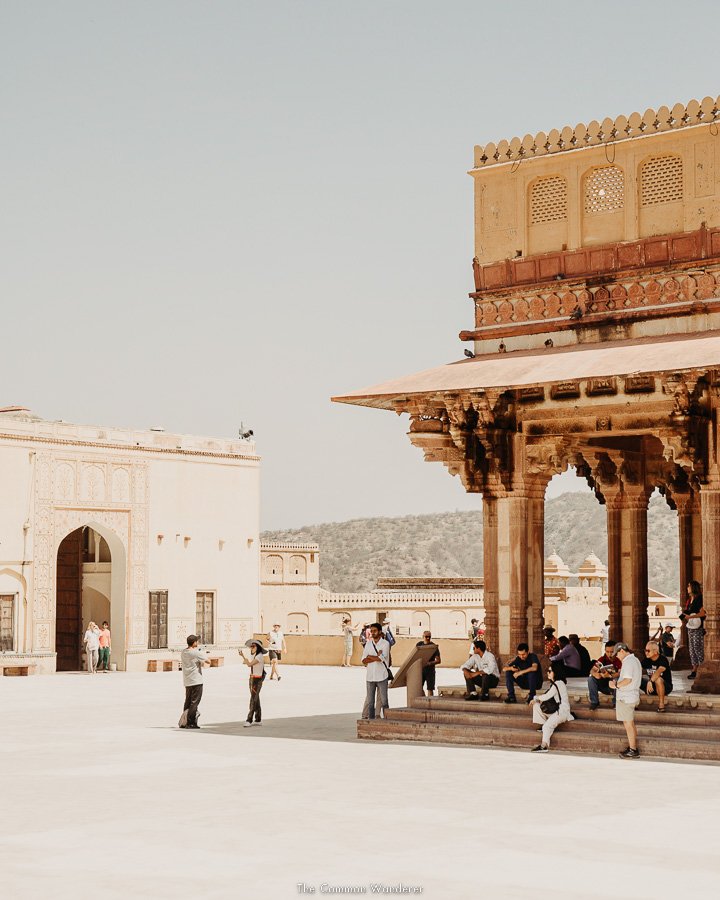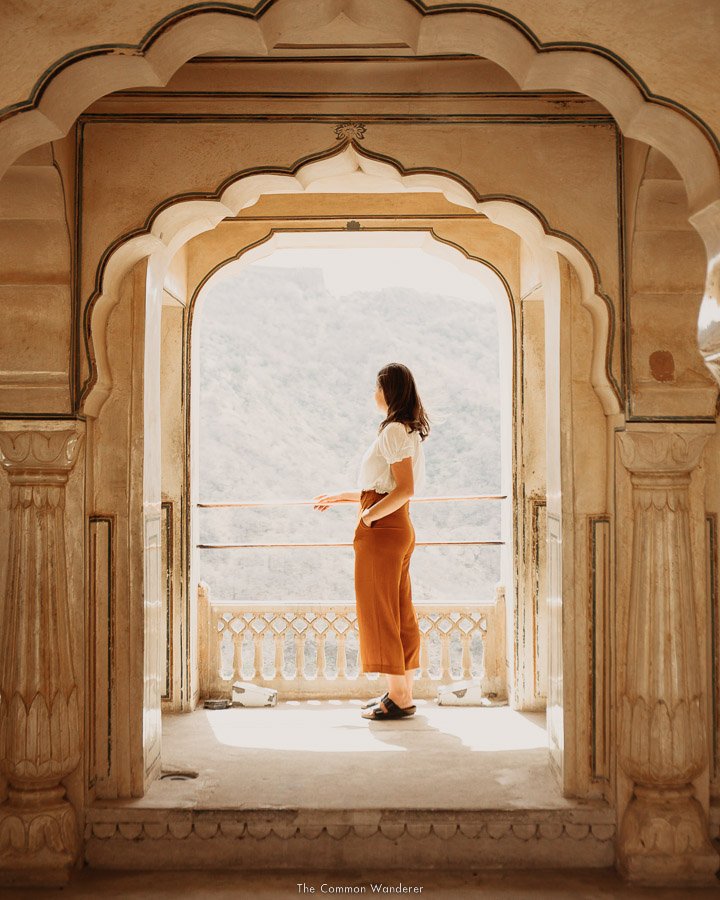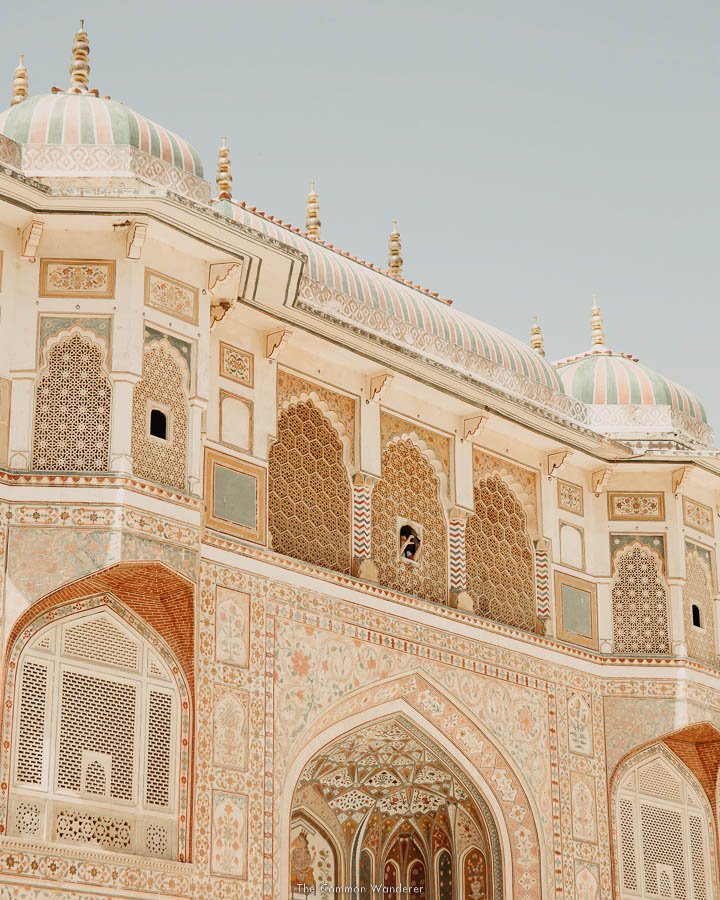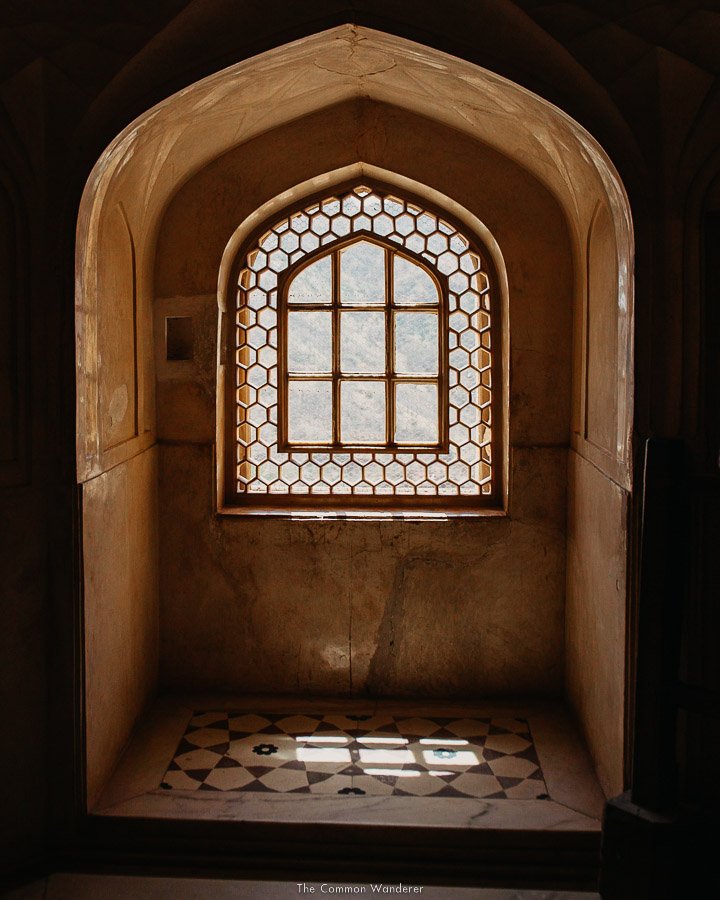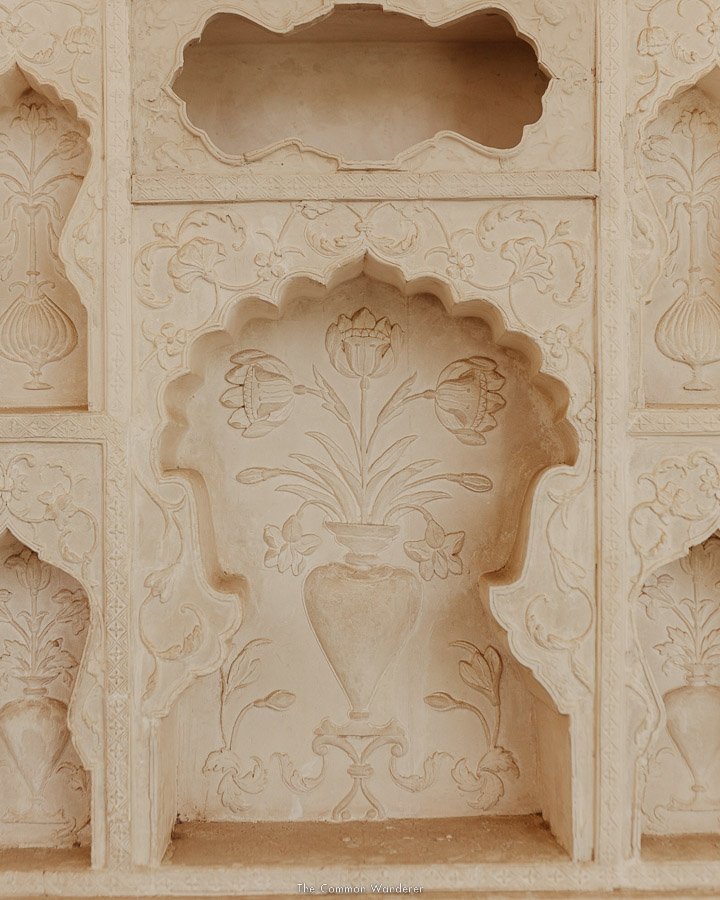A Detailed Guide to Amer Fort (Amber Fort), Jaipur's Golden Palace
Serene Amer Fort is one of the most incredible places to visit in Jaipur. This detailed guide covers all corners of Amer Fort, including what to see and do, fees & opening hours, and how to get there.
As you catch your first glimpse of Amer Fort sitting perfectly atop the rugged hills of Aravalli, you’ll immediately be swept off your feet.
The Amer Fort (otherwise known as Amber Fort) is a palace like no other. A gorgeous piece of ancient architecture that has stolen the heart of many travellers from around the world, and rightly so.
Becoming more beautiful as time passes, Amer Fort is the perfect fusion of the finest Rajput and Mughal styles of architecture - a UNESCO World Heritage Site dreamland of pastel-hued sandstone and licks of white marble, enchanting courtyards, gardens to frolic within, intricate archways overhead, flowing serpentine staircases, endless floral patterns adorning the walls, and some seriously good looking gates.
Set 11km on the outskirts of Jaipur, the huge and well-maintained complex overlooks the charming Maota Lake and connects to the impressive Jaigarh Fort through a set of underground tunnels.
With four expansive sections, we suggest you spend a solid 3 hours navigating your way through the maze of exquisite hallways and cobbled paths, admiring every courtyard, opulent royal room and breathtaking view she has to offer.
For those of you planning to visit Amer Fort, this guide will give you everything you need to plan your own visit to one of Jaipur’s most incredible and popular attractions.
Just remember to pack a camera, you’ll be taking a lot of photos.
LOVE OUR PHOTOS? Edit like us with our Indian Odyssey Preset Pack, and Tropical Bliss mobile video filters, inspired by the tropical beauty and colour of this beautiful country
AMER FORT
ESSENTIAL INFORMATION
WHERE | Amer Fort, Jaipur
HOW TO GET THERE | Bus, auto-rickshaw, private tour
WHAT TO SEE | You can’t miss Suraj Pol, Jaleb Chowk, Diwan-i-Am, Ganesh Pol, Jai Mandir
TOURS | Purchase your Amer Fort fast-track ticket here, OR this highly-rated Amber Fort guided tour
BEST TIME TO VISIT | March - April, arrive early
HOW LONG SHOULD YOU SPEND? | 3+ hours to fully appreciate the Fort
A LITTLE AMER FORT HISTORY
Amer or Amber Fort is believed to have first been established in 967 AD, when Raja Alan Singh, a ruler of the Chanda clan of Meenas, settled here.
Later in 1592, Raja Man Singh, a ruler of the Kachwaha Rajputs, built upon the remnants of the earlier structure which then became the grand residence of the Rajput Maharajas and their families.
Over the next 150 years, the fort was further expanded, with Rajputana successors like the notable Sawai Jai Singh adding magnificent elements of architecture to it, becoming the Amer Fort we notably know today.
Now, it’s an enthralling reminder of the royal era and one that tells a thousand and one stories and was rightfully ascribed UNESCO World Heritage status in 2013.
WHAT TO SEE IN AMER FORT (AMBER FORT)
Because of the vastness of the complex, you can get yourself into a bit of a pickle trying to find your way around Amer Fort, especially if you’re wandering solo.
So, here is a section-by-section guide to help you find, and truly understand the must-see areas in the complex and ensure you don’t miss a single thing:
JALEB CHOWK / GANESH POL
If you arrive at Amer Fort by foot, you’ll enter through the majestic Suraj Pol (Sun Gate). Every morning the beaming sun rays fall first on this entry gate - hence why it is also known as Sun Gate. If you arrive by car at the back entrance, you will enter through Chand Pol (Moon Gate).
No matter which gate you enter through, you will be led to Jaleb Chowk - a large, ornate courtyard that will take your breath away. This place enchanted me right off the bat and got me so excited to explore more!
Here is where you will see the iconic and oh-so-gorgeous gateway called Ganesh Pol, intricately painted and featuring the artwork of the Elephant god - Lord Ganesha - it’s an absolute hotspot for photographers (read our photography tips here!
If you are visiting first thing in the morning, then to your right you may also notice the locals paying their respects to Shila Mata - the Hindu goddess, in the historic holy temple of Shila Devi.
DIWAN - E - AAM
Take a wander through the second courtyard, Diwan - E - Aam (The Hall of Public Audience).
The many large marble stone pillars, elephant-head carvings, beautifully framed archways and precious stonework are striking - as are the panoramic views overlooking the rugged hills of Jaipur and the shimmering Maota Lake below.
It is known that Diwan - E - Aam is where the king held meetings to hear the public's requests and needs.
SUHAG MANDIR
Located on the stairs just above Ganesh Pol is a gem that is easily missed.
The framed lattice screens you see are where the women used to peek out and watch the soldiers who would assemble to celebrate their victory on Jaleb Chowk, as the women were not allowed in said courtyard below.
SHEESH MAHAL / DIWAN - E - KHAS
As you wander through Ganesh Pol you will then enter the third courtyard. On one side is Diwan - E - Khas (The Hall of Private Audience), otherwise known as Sheesh Mahal (Hall of Mirrors), as it quite literally is that - a hall completely embellished in a dazzling mirror mosaic. The teensy pieces of glass were imported all the way from Belgium. Just stunning!
The hall of Diwan - E - Khas is where the king held his meetings and parties. It is said that one single candle can light up this entire place.
It’s that captivating in the day, I don’t know if I could even deal with how gorgeous the twinkling ceiling full of stars must look at night!
SUKH NIWAS
On the other side of the third courtyard, you will see Sukh Niwas (Hall of Pleasure), the private chamber of the king. This overlooks a lovely Mughal-style ornamental garden called Char Bagh.
The Sukh Niwas was kept cool in the summertime by an artificial creation of winds that would blow over a water cascade within the palace.
ZENANA MAHAL / BARADARI
Through the connecting corridor, you’ll find the fourth courtyard, best known as the Zenana Mahal, which was once home to the royal women of the palace.
This is another epic spot for views across the valley and gooorgeous detailed architecture - a favourite being the pretty pink and white floral details surrounding each doorway.
At its centre lies a raised pavilion called Baradari which was known to be the meeting hall for the queens and is the oldest structure in the entire Amer Fort. Encircling the courtyard are the rooms which were the women’s living quarters.
The layout of this courtyard was done so in a way that the king could visit one queen, without another queen noticing - so sneaky!
INSIDER TIP | Before following the main signs from the third courtyard to the fourth, I’d highly recommend taking a wee detour by finding the small door that leads you to the old washrooms. Just next to those you will spot a room filled with teeny latticed windows that cast a beautiful star-patterned reflection on the marble floors.
The perfect fairytale photo opportunity! After a wander and a cheeky snap or two, you can then make your way through to the rooms of the Zenana Mahal.
AMER FORT LIGHT AND SOUND SHOW
Every night from 6:30 pm the fort lights up for a popular Jaipur attraction - The Amer Fort Light and Sound Show.
Amer Fort is seen in all its glory, brought to life with colourful, illuminating lights and historical stories told of the legends of the Rajput Kings.
THE DETAILS
Where | The performance takes place at Kesar Kyari on Maota Lake at the foot of Amer Fort
Cost | INR 295
Duration |50 minutes long
Show details | English version, 6:30 pm (October - February) / 7 pm (March - April) / 7:30 pm (May - September)
THINGS TO SEE CLOSE TO AMER FORT
GREAT WALL OF AMER VIEWPOINT
That long line of stone walls you see up on the jagged mountain ridges from Amber Fort? It’s the incredible, historic and inspiring Great Wall of Amer, a hidden gem that goes hand in hand with the beauty that is Amber Fort.
A kilometres-long fortification with watchtowers dotted along the way, The Great Wall of Amer was built in the 16th century to serve as a line of defence for the Amber Fort and the city from invaders.
It’s known as the third longest wall in the world, following behind Rajasthan’s finest - Kumbhalgarh Fort, and of course, the Great Wall of China.
The Great Wall is the spot to climb up and see the most insane views over the city of Jaipur, the Aravalli ranges, the idyllic Rajasthani desert, and of course Amber Fort - a Jaipur sightseeing treasure!
It’s not as well known as some of the other Jaipur attractions, which makes it the perfect hideaway from the hustle and bustle of the Pink City.
To get to the main viewpoint, enter directly opposite the entrance to the Amber Fort where you will spot a small blue shrine. Here you will find a staircase leading to the top of the Great Wall.
The staircase is steep and you’ll have to trudge up a few steps (over 350) for around 20 - 25 minutes before reaching the top. You’ll be treated to mind-blowing views for days!
THE DETAILS
Where | Great Wall of Amer
Cost | No entry fee - beware, if someone asks you to pay a fee just know it’s a tourist trap and not to pay anything.
When to go | The Great Wall is undoubtedly one of the best sunrise and sunset spots, ideal for capturing that golden glow. Just be careful when climbing up or down the stairs in the dark!
How to get there / Transport | Just like reaching Amber Fort the best options are to take a local bus, auto, or taxi - as noted above. Take note if you are planning to visit the viewpoint for sunrise, the local buses may not be available that early in the morning - something to check the night before.
PANNA MEENA KA KUND
Panna Meena Ka Kund is a gorgeous little stepwell situated a mere 10-minute walk around the corner from Amber Fort - so it's perfect to pair these Jaipur attractions together and make a day of it.
There’s something about the geometry of these 500-year-old steps that make it a photogenic wonderland.
THE DETAILS
Where | Panna Meena Ka Kund
Opening Hours | 7 am - 6 pm daily
Cost| No entry fee
AMER FORT TRAVEL INFORMATION
AMER FORT (AMBER FORT) OPENING HOURS AND ENTRY FEE
Amer Fort is open daily, between the hours of 8 am - 5:30 pm.
As of 2022, entry fees are INR 550 ($7 USD) per person for foreigners, or INR 1,000 for a composite ticket (which includes entry to Amber Palace, Jantar Mantar, Hawa Mahal, Nahargarh fort, Albert Hall and more).
BOOK | Purchase your Amer Fort fast-track ticket here
NOTE | Still and video cameras are allowed, however, tripods are not.
WHEN TO VISIT AMER FORT
Amer Fort is best visited during the months of March - April, when the weather in Rajasthan in mostly pleasant, and not too hot.
During winter (October - February) is also a great time to visit, with dry and cool temperatures making exploring the Fort manageable.
Try to avoid May, when the heat is extremely oppressive (our visit was 42 degrees!)
Amer Fort is best visited first thing in the morning, to avoid the heat, and also the vast crowds that begin to arrive from 10 am (always rely on humans to enjoy a sleep in, and you’ll have most attractions to yourself!).
Alternatively, late afternoon is a great time to visit, when the crowds have dispersed, and the heat has reduced.
WHERE IS AMER FORT, AND HOW TO GET TO THERE
Amber Fort is located around 10km northeast of the centre of Jaipur, nestled in the extensive and rocky Aravalli mountains that circle the north of the city.
BUS
Public bus route #1, #5, or #3B runs every 20 minutes from Ajmeri Gate or Hawa Mahal and will take you to Amer town. The journey will take 40 minutes and cost roughly INR 15 for non - AC / INR 30 for AC. If you’re unsure just keep an ear out for the conductor yelling ‘Amer.’
AUTO RICKSHAW / TAXI
The journey will take 15 minutes and cost roughly INR 500 return trip. Not too badly priced to split between a group (just remember to bargain a little bit!)
You can book these from the side of the road, ask your accommodation to arrange one for you, or check out the Uber / Ola apps.
TOP TIP | If you’re taking a taxi I highly recommend booking a return trip (the taxi driver will wait for you until you’re done). That way you don’t have to muck around with finding a driver home as they can be sparse and expensive.
THINGS TO KNOW BEFORE VISITING AMBER FORT
TO HIRE A GUIDE, OR NOT?
To hire a guide or not to hire a guide... this here is completely up to you!
We’ll be upfront and say that we hired a guide, and it was a wonderful experience to gain a greater understanding of this joyous structure.
If it’s important for you to hear all the details about the history of Amer Fort, understand the significance, learn facts behind each section of the palace and not get lost in the maze of hallways - then we highly recommend hiring a guide.
You can book a guide prior to your visit (we recommend this highly-rated guide), or when you arrive on site.
In order to do so, make your way towards the main ticket counter located in the Jaleb Chowk courtyard where you’ll find an abundance of official tourist guides begging you to let them take you on a tour through the Fort.
Do check for a valid ID of your guide before commencing, as the last thing I want is for you to get ripped off! On average a guide for a 1- hour tour should cost you roughly INR 300.
Alternatively, exploring the Amer Fort complex is easily done without a guide!
Without a guide, you can take your time and explore every nook and cranny at your own pace. If you’re happy to spend time doing a little research beforehand and downloading a map on your phone, then go for it!
BOOK | This highly-rated Amber Fort guided tour
DON’T RIDE THE ELEPHANTS
If you know us at Team TCW, you’ll know we hate all kinds of animal tourism, so when you visit Amer Fort, for the love of Ganesh, don’t ride the elephants.
These precious animals have to undergo torturous mistreatment in order to tame them enough to allow passengers to hop on them.
Don’t be that person.
If you are unaware of the cruelty associated with animal tourism, please do your research.
At a hefty INR 1,100 per elephant to carry 2 passengers up the hill, there’s zero reason to take one.
To make your way up the hill from the foot of Amer Fort to the entrance, you have a few options that don’t involve cruelty to animals.
We suggest taking it by foot, a mere 10 minutes walk up a slope. Easy peasy!
RESPONSIBLE TRAVEL IN INDIA
Responsible, sustainable travel is what we’re all about here at TCW HQ, and this is especially true when we travel to places suffering from climate change and plastic pollution, such as Jaipur.
TRAVEL DURING SHOULDER SEASON | Shoulder season is the time before and after the peak season when things are quieter, cheaper, and more enjoyable. Travel then to reduce over-tourism, and extend the season for local operators
DON’T BUY BOTTLED DRINKS | Please, for the love of the ocean: DO NOT BUY SINGLE-USE PLASTIC BOTTLES! You'll understand why when you see a bunch of plastic bottles bob past you in the open sea. Buy one of these fantastic bottles instead
USE LESS WATER | To help reduce the pressure on water supplies, keep your water usage to a minimum. We know that’s hard to do on holidays, but quick showers, and turning the tap off when brushing your teeth, cleaning etc. really help
DO YOUR OWN CLEANUPS | See rubbish on the beach, forest or town? Pick it up, and dispose of it properly. If every traveller helped out during their holiday, the beaches, oceans and forests would be a much happier place for it
DON’T USE PLASTIC BAGS | Pack a reusable tote and use these to carry your snacks, drinks, or new souvenirs instead
LEAVE NO TRACE | Limit your consumption of plastic, and opt for sustainable / zero-waste alternatives instead. Pack a reusable water bottle, bring your reusable coffee cup, and if you can’t sip your cocktails without a straw, bring a metal or bamboo one along instead. And never leave a trace...
BE ANIMAL-FRIENDLY | Don’t participate in any form of animal tourism/abuse, and observe animals from a distance
SUPPORT THE LOCAL COMMUNITY | Visit a locally owned taverna for a meal, buy which means both supporting the local economy and community, and also giving you a real authentic experience.
TRAVEL INSURANCE | STAY SAFE IN INDIA
If you can't afford travel insurance, you really can't afford to travel. As the current global situation has taught many people, things can go wrong anywhere in the world - and insurance is often the only way of mitigating any issues with minimal expense or stress for you.
For all travellers | HeyMondo - COVID-19 coverage, comprehensive travel + medical insurance, an app with 24-hour medical support, and no out-of-pocket fees. *Get 5% off your policy by booking through our link here.
For digital nomads | SafetyWing - COVID-19 coverage, comprehensive travel & medical, and policies can be purchased while already abroad.
Car Insurance | Insurance4CarHire - a great annual car insurance policy
*In normal times, we recommend using World Nomads travel insurance, but unfortunately they're not currently covering COVID-19-related claims right now.
EXPERIENCE THE BEST OF INDIA
THE BEST OF JAIPUR | The best places to visit in Jaipur, A guide to the stunning Jaipur City Palace, A guide to the stunning Hawa Mahal, How to visit Nahargarh Fort
INDIA ITINERARY | Our detailed three-week India Itinerary, Everything you need to know before catching trains in India, Experienced the magical city of Bundi
COWS, CURRIES AND COLOUR | A must-read from our three weeks travelling India by train
PHOTOGRAPHY | Love our photography? Wondering what gear we use to get all of our photos around the world?
Click here to view our detailed photography gear guide, as well as our top travel photography tips!
RESPONSIBLE TRAVEL | Responsible travel is important. REALLY IMPORTANT. Learn our top responsible travel tips to help you, your family and your friends travel more consciously around the globe
ECO-FRIENDLY PACKING ESSENTIALS | Don’t leave home without our favourite eco-friendly travel essentials
PLAN YOUR TRIP TO INDIA WITH THESE POSTS!
Article written by Briar Jones: Briar is a free-spirited Kiwi traveller, creative graphic designer, illustrator and dabbler in photography. She’s spent her entire adult life solo backpacking around the world, having now found a home in India, her favourite place on earth. She’s a lover of a good roadie through the mountains, music flowing, with her camera in hand.
You can follow along with her adventures on Instagram @briarashleigh.
Some of the links on this Bundi post are affiliate links.
If you choose to purchase using these links, we receive a small commission at no extra cost to you. Please know that by using these affiliate links, you're directly supporting The Common Wanderer to stay wandering, the running costs of the site, and our ability to provide you with free content to help you on your travels.
That, and you're officially a legend.









